Double Trouble
By Betsy Crowfoot
One Pacific Cup racer loses its rudders, another drops its keel, but their crews' quick thinking and ingenuity get them safely to port
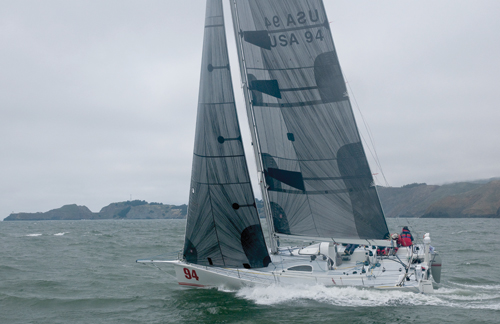
"Ruh-roh," I blurted (to quote Scooby Do). I was tracking some friends who were competing in the Pacific Cup aboard the brand-spanking-new Antrim Class 40 California Condor, a sistership to the boat I race on, Yippee Kai Yah.
A modern offshore racing design very popular overseas, California Condor had been launched just six weeks before the July 8 start of the offshore distance race. But her accomplished crew-including designer Jim Antrim-was rocketing up the learning curve. Just four days into the race California Condor was neck-in-neck with Horizon (the Santa Cruz 50 that would go on to win the Pacific Cup) and expecting to finish in another five days or less.
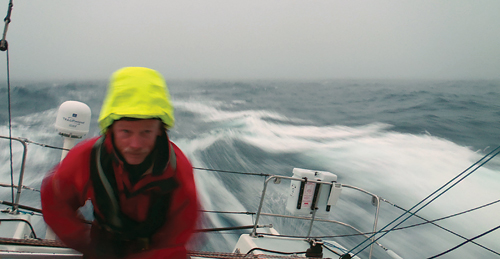
And then, almost halfway into the 2,070-nautical-mile race from San Francisco to Kaneohe, Oahu, not one, but both of her twin rudders broke.
Double ruh-roh!
And if that sounds bad, imagine losing your keel in the middle of the Pacific Ocean, like the 30-footer Warrior's Wish did on the trip home from the same race.
These two separate incidents surrounding the Pacific Cup during the passage home have highlighted the need to be prepared for any and all circumstances when you leave port, particularly on long ocean passages.
California Condor was commissioned by San Francisco Bay Area racer Buzz Blackett and built at Berkeley Marine Center. Roughly 100 Class 40s have been launched worldwide in recent years. Forty feet long and 14.7 feet wide, with a large, breezy cockpit, twin rudders and massive sail area balanced by a water ballast system, the Class 40 is a racing machine.
Several days after the Pacific Cup start, California Condor reported, "Too fast to blog yesterday, certainly too fast for pictures," while recording a record speed of 20.2 knots in 22 knots of breeze.
A day later, all that would change. In the wee hours of the morning July 13, amidst a spinnaker-changing snafu, the crew heard a "clunk" and the helm got "very stiff." On inspection they discovered, "the port lower rudder gudgeon had broken," according to Antrim. One side of the metal strap that wrapped around the front of the rudder had sheared.
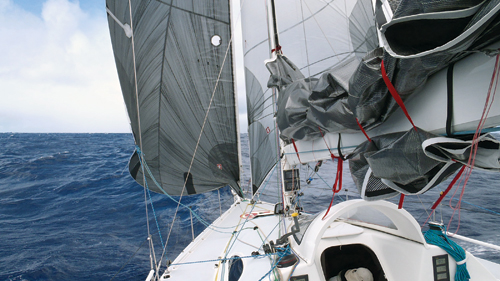
"We were able to remove the rudder and jibe onto starboard, and sail with the starboard rudder," crewmember Liz Baylis said. "We were almost at our jibe point so it didn't seem too bad."
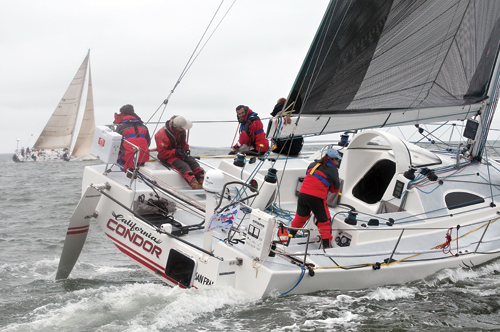
As a precaution, Antrim suggested they take it easy and not work the steering too hard, so they set the jib and not another spinnaker. "Things seemed good and everyone got a bit of rest after a long night of wrestling sails and rudders," added Baylis.
But shortly after roll call the next morning, the second rudder failed too. The lower gudgeon broke loose and the rudder started swinging wildly back and forth, as the boat rounded up. On board this swift racing boat with no steerage, it was chaos. All hands on deck helped drop the sails and get the damaged rudder on board, then they set out to deploy a drogue to stabilize the boat to course.
"I had never used a drogue before, except when filming a heavy weather sailing video about 20 years ago, so this was my first experience with one for real," Baylis said. "We had brought a Jordan Series drogue with us and let me say that now I am a complete advocate of this product!"
The drogue consists of hundreds of small cones woven into a tapered line, designed to be dispatched behind the boat, the number of cones and length of line set out being dependent on the boat's displacement and the sea state. Typically, it is used as a safety device to prevent capsize in severe storm conditions by maintaining the stern to the seas and minimizing speed. (See sidebar on page 55.)
Initially the crew deployed the drogue and set a staysail and jib wing-and-wing. "The boat practically steered itself," Baylis said, "but, we were going really slow and the boat was pretty loaded up from the force of the wind on the sails and the drag of the drogue."
In addition, the crew was concerned about water and food rations and how long it might take to get to land. So, Baylis said, "we came up with a plan to reduce the drag of the drogue while still keeping it effective."
They removed one of the two sections of cones, but then the boat "careened all over the place." Subsequently they added some anchor line and chain to the end, which offered more stability and speed. "It was a bit like a bucking bronco to control, but after a little bit of time the whole crew got the new system down. It was pretty physical trimming when the breeze rose above 18 knots but we were making progress toward Hawaii."
Baylis said the tone on board was "surprisingly positive; no 'Woe is me.'" Getting to the finish became the new challenge. After celebrating Baylis' birthday (her husband even baked a cake on board) they arrived late during the night of July 21.
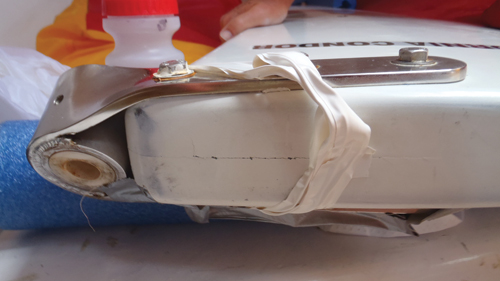
After successfully finishing the singlehanded Transpacific race from San Francisco to Hanalei Bay, Kauai, aboard the Mount Gay 30 Warrior's Wish, Ronnie Simpson was joined by Ed McCoy for the return delivery.
Warrior's Wish was built to the Mount Gay 30 box rule. Designed by Scott Jutson in Australia, where she was built in 1999, Warrior's Wish is a 31-foot-long, 6,000-pound sport boat with more than 10,000 miles of successful racing at sea.
Thirteen days into the arduous passage home, Simpson reported twice hearing "a loud pop." In both instances the men checked the rigging and chainplates, but could find nothing wrong.
The third time, Simpson felt a movement through the deck coinciding with two loud "pops." McCoy tore up the floorboards, examining the hull for cracks or damage, but they would need to wait until first light to confirm their greatest fears. They triple-reefed the main and put up a No. 4 headsail, and weathered the rest of the night warily.
At dawn, Simpson dove over the stern to inspect the hull. "I saw the rudder and the sail drive, but not the keel. My brain wasn't wanting to believe what my eyes were telling me … the keel was completely, 100% gone. Utter shock. If I had expected any kind of big failure it would be dropping rig or losing a rudder."
They immediately doused all sails and evaluated the situation. "Could we keep the boat from capsizing? Could we attempt to make it back? Or try to get rescued?" Already, Simpson said, "we both realized we'd dodged a serious bullet," when they didn't flip during the night.
"We put every single thing we could into the middle of the boat on the cabin sole," including some 500 pounds of fuel they took on from a passing containership. When they emptied a jerry can of fuel, they filled it with salt water and stowed it below, putting "every bit of ballast we could into the bilge, to get the weight as low as possible."
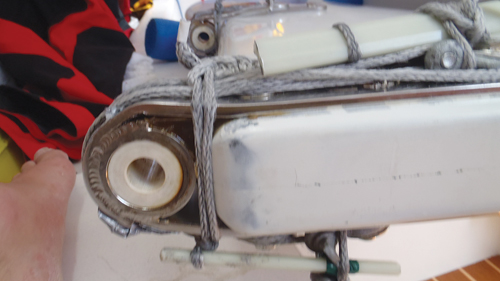
Maneuvering was difficult, as the boat had a significant leeward helm, which they noticed was less severe the faster they moved. Eventually they put up their smallest headsail, which increased boat speed from 4 knots to 7. Later, Ronnie would admit to wishing he had a 15- or 20-horsepower diesel engine, instead of nine, as their fair weather window was closing.
For seven tenuous days (nearly 800 miles) they coddled the engine, keeping the headsail tightly trimmed for extra speed and stability. Simpson slept in his foulies and a PFD, "with one hand on the ditch bag and a pocket knife in my pocket," ready to deploy the life raft that was now stowed on deck. Yet he still maintained a sense of humor.
"I never realized how awesome a keel was until it left me," he wrote in his blog. "What a glorious, 2,500-pound lead fin that thing was." They arrived in San Francisco predawn on August 18.
"The biggest thing I took away from this is that I would not have been prepared, had the boat rolled, with the placement of the life raft, epirb, ditch bag; even the clothes we were wearing," Simpson admitted. "It was midnight, super dark. It would have taken us both by surprise. It would have killed us.
"You've got to be ready to actually ditch the boat, be ready for the worst thing at any moment."
Ronnie, like a cat, has already exhausted a few of his nine lives (see his website at www.openbluehorizon.com) but isn't put off of bluewater racing. He got back on the horse right away and hopes to campaign a mini-Transat in the 2013 event.
"Most boats that have lost either their bulbs or their keels have just rolled over and the crew hasn't had the opportunity to really do anything, except save themselves," pointed out Chuck Hawley, West Marine's Safety at Sea expert.
Take Pandemonium. In August of 1989 this 66-foot ultralight yacht was returning to San Francisco from the Transpac race, with just 300 miles to go. Without warning the keel parted and the boat flipped. All five crew were ultimately rescued from life rafts by a freighter.
Hawley speaks from experience. He was skipper of the 67-foot sled Charley returning from Transpac after a swift nine-day race in 1983. Just two days into the delivery home, 288 miles north of Hanalei Bay, the boat stalled. Hawley initially thought the driver had run over a net, when, he said, "we looked and could see the keel bolts sticking down into the water."
The keel had inexplicably parted. "We struck the sails very quickly, and brought the boat into the wind under power, put all of the sails on the weather side, and prevented the boom to weather," all to counteract the windage in the rough conditions.
As they still had sufficient fuel, they motored back: but in tenuous, gusty conditions. "The boat was very rolly and hard to keep on course. At times we probably rolled over 60 degrees," said Hawley, adding that the designer, Ron Holland, "was incredulous (to hear) the boat had remained upright."
In all of these instances, quick reactions and outstanding seamanship prevented unexpected malfunctions from becoming tragedies. Hawley now makes a living lecturing on safety.
"Make sure life rafts can be launched regardless of the boat's attitude. Have a ditch bag ready to go at all times. Discuss standard operating procedures with your crew before departing. And once in trouble, maintain a radio watch with the U.S. Coast Guard so they can be aware of your situation, " Hawley said. "Only take reliable boats that do not put their crews in danger to sea."

Comments